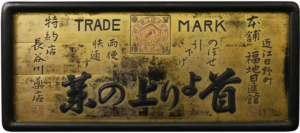Let us go back to the year 1603 when Japan entered an era of prosperity and economic development, after the crippling almost continuous military wars and social turmoil of the 14th century eventually concluded. The streets of Japanese towns were crowded with stores and small businesses competing for customers as the economy of the world flourished.
These are the streets where the word “KANBAN” was born, “Kan” meaning sign and “Ban” meaning a board. Shop owners made these signs to attract the customers. Hypothetically, if I was running a business and the street is crowded then I am not able to answer all customer queries at the same time . In that case, would creating a sign board with a purpose of creating a visual one way communication channel , to answer general queries about service provided and cost answered ?

In this case the board was created not just to attract customers but to provide them with key information on the kind of service the stores provide and highlight the business uniqueness, which will then allow the customers to make a better decision checking if the service provided satisfies their needs .
If we for a moment analyse this hypothesis , one of the practices that stands out is creating transparent visual representation and change the board to better address customer queries , which highlights a key principle to Improve every process .
If we further observe the history, the Kanban methodology emerged in Toyota production system (TPS) Taiichi Ohno known as the father of the Toyota Production System, identified patterns of inefficiencies and wastages in the production line. He started seeing the unnecessary wastage in inventory and processes in their operations.
In Toyota, they realised that the supermarket stock concept has a potential to be implemented at scale in a production line. If you imagine a supermarket , the products are stocked and arranged in a pattern which made it easy for the workers to not only recognize when the stocks number reduce but also plan what quantity is needed to re-stock the same .
The preceding process, who is in charge of making the parts ready, supplies the parts to the next process when they need it and only in the amount needed.
Applying the same principle used in the form of “Kanban”, to easily communicate within the shop floor, they used visual cues to indicate their need for a part in the form of cards. In this context Kanban is translated in Japanese for “card” .
This helped them reduce waste and boost their efficiency in the process. For both the workflow and the real job that goes through the workflow, Kanban offers a visual picture. It has helped companies detect possible challenges and bottlenecks in the workflow since its development, helping them to solve the problem and let work flow effectively at an optimum speed or throughput.
If we again observe the above practices that stands out in establishing TPS , a few key principles again start to emerge (1) Constancy of purpose (2) awaken to the challenge, must learn their responsibilities, and take on leadership for change (3) aim of management should be to help people to do a better job.
This raises the question, how did these principles emerge and who pioneered this research ?
Let us explore the above question in detail in The Evolution of Kanban – Part 2 .